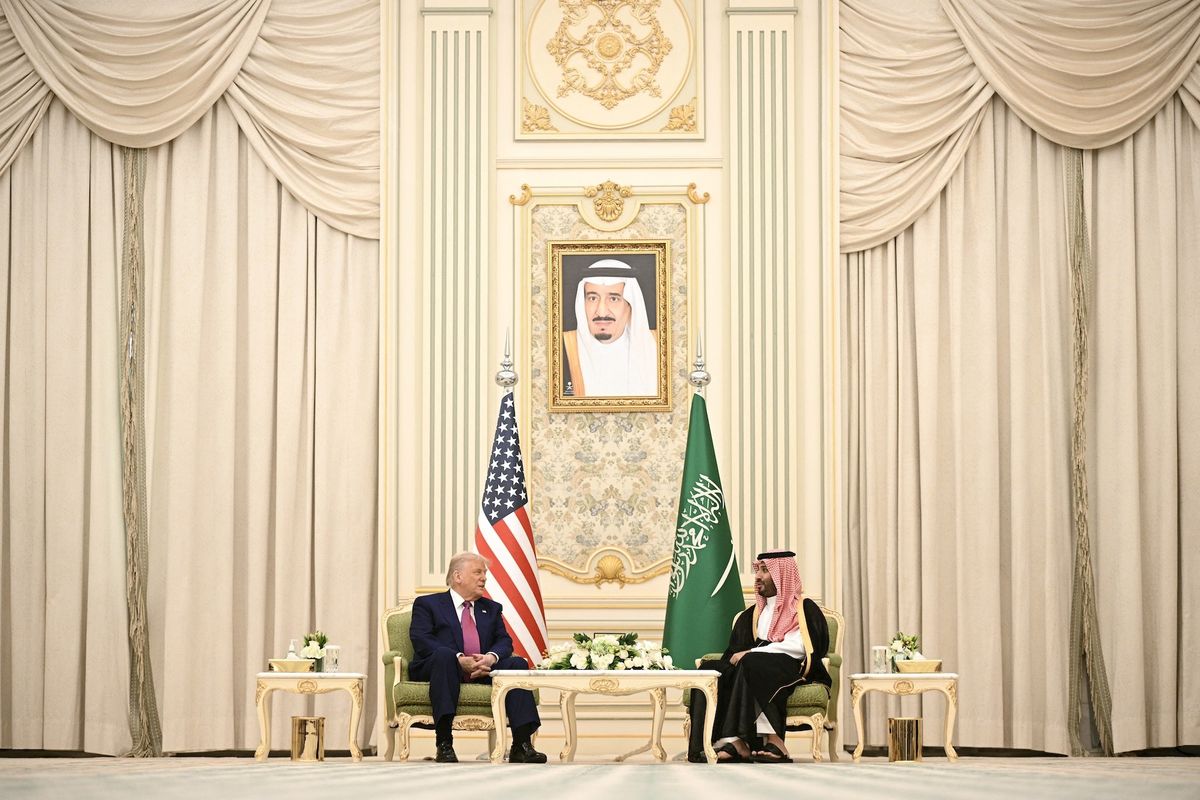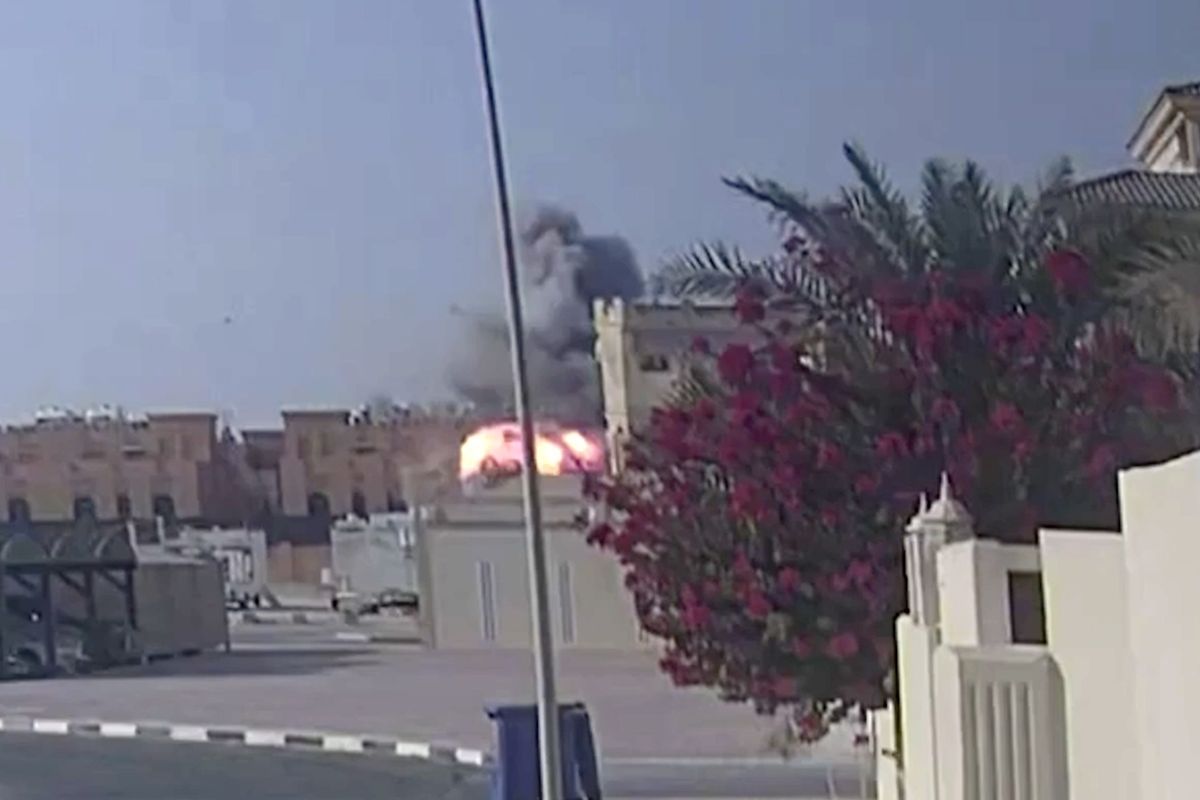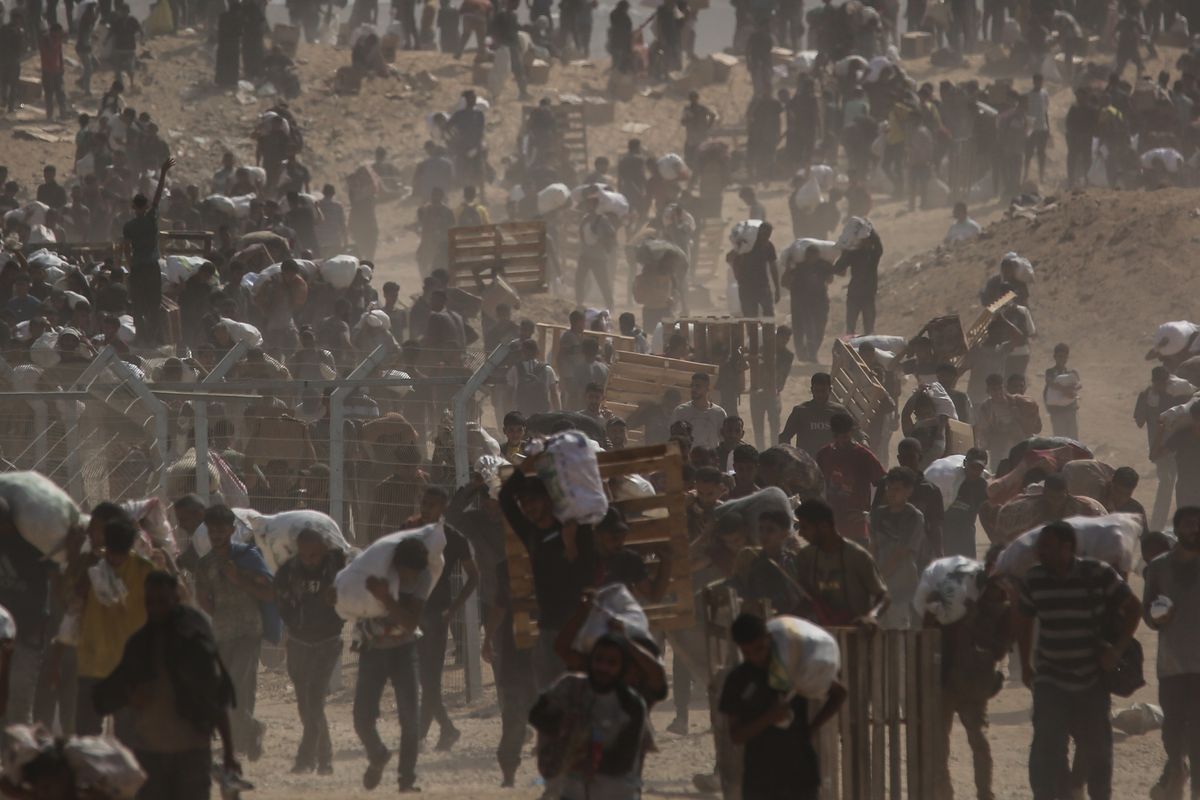Just last month, the long-simmering Israeli-Iranian conflict came out of the shadows when Iran sent a drone across the Jordanian border into Israel, and Israel retaliated with air strikes on several targets including the Iranian drone operators at a Syrian base in Palmyra, northeast of Damascus. The two sides appear to be on a collision course as Iran penetrates further into a hollowed-out Syria and Israel tries to frustrate that effort. The current status quo, where Israel limits itself to enforcing its publicly stated red lines in Syria, is likely to continue. However, new events that change the intentions of the parties could lead to miscalculation and uncontrollable escalation.
Iran’s strategy since signing the 2015 Joint Comprehensive Plan of Action (JCPOA) nuclear agreement was to trade short-term nuclear weapons capability for regional expansion and ballistic missile build up. The Supreme Leader of the Islamic Republic Ayatollah Ali Khamenei came away from the deal with the ‘P-5 plus 1’ with what critics of the deal see as an option to pursue a nuclear weapon in the future.
He also gave a green light to the Islamic Revolutionary Guard Corps (Revolutionary Guard) to pursue a pan-Shia axis throughout the Arab world and especially in the Levant. The Obama administration largely looked the other way as Iran’s Islamic Revolutionary Guard Corps came to Syrian leader Bashar Assad’s rescue in Syria. When the Russian air force joined them in 2015, the Revolutionary Guard accelerated their domination of the Syrian regime.
The Islamic Republic’s strategy can best be summarized as seeking a robust defense through an aggressive offense. To avoid a repeat of the painful Iraqi invasion of Iran in 1980, which scarred the psyche of the current leadership of the Revolutionary Guard, the Islamic Republic prefers maximum ‘strategic depth’ far away from its borders through increasing influence in Arab capitals such as Damascus, Beirut, Baghdad and Sanaa.
The Islamic Republic’s modus operandi is to stay under the radar and avoid making beheading videos and other sadistic behavior typical of ISIS. Let Iran’s adversaries like the U.S. defeat Iran’s existential enemies, like Saddam Hussein and ISIS. While the U.S. focused on leading an international coalition to fight ISIS in Syria and Iraq, Iran and Russia came to Assad’s rescue by targeting less extremist Sunni rebels who have now been largely defeated and whose families have been for the most part driven out of their homes.
The Revolutionary Guard has gone from success to success in an Arab world weakened by the aftermath of the Arab Spring revolts, as is most evident in Syria. A hollowed-out Syrian regime is more indebted to Iran and its proxies than ever before.
With respect to Israel, the Islamic Republic until recently maintained a policy of having sticks along Israel’s borders to poke at Israel (such as Hezbollah and Hamas) in order to deter Israel from ever considering an attack on Iran’s nuclear weapons plants at home. Now, the Revolutionary Guard appears to have become more ambitious, and is building a transnational Shia militia group in Syria and across the Middle East along with military installations, precision missile factories and Shia proxy forces that are answerable directly to the Revolutionary Guard and not to Assad. Their ambitions are to have Shia militias on Israel’s borders with thousands of precision missiles aimed at Israeli critical infrastructure. Just like North Korea has thousands of missiles threatening South Korea, Iran through its proxies can similarly try to threaten Israel.
The Islamic Republic has supplemented its moves on the ground with rhetoric calling for the liquidation of the state of Israel in 25 years. Iran leads the “Resistance” against Israel, a movement that includes Hezbollah, Hamas and growing numbers of foreign and local militias in Syria. Israeli leaders worry that the Islamic Republic has a long-term goal to surround Israel’s borders: in the north, Hezbollah and now Syria; in the east, Hamas joined by some disillusioned Fatah members in the West Bank (and maybe someday a post-Hashemite pro-Iran Jordan); in the south, Hamas and Palestinian Islamic Jihad in Gaza.
At the moment, the Revolutionary Guard is riding high after its successes in Syria and elsewhere, which is stoking the fears of Sunni Arab states and Israel. But extrapolating current successes into the future is highly uncertain. The Islamic Republic’s strategic fallacy is that, first, they assumed that the U.S. policy of retrenchment and reticence would continue beyond the Obama administration. It has not, and now that National Security Advisor designate John Bolton and Secretary of State-designate Mike Pompeo will be leading America’s diplomacy with the enthusiastic backing of President Donald Trump, stepping up the effort to stop Iranian aggression may only be the first phase. Trump’s national security team has signalled it may be followed up with a containment policy that draws attention to Iranian quagmires resulting from its Revolutionary Guard’s foreign adventures.
A second fallacy is Iran’s rationale for their aggressive policy across the Levant as a defensive posture, which follows the maxim that it is better to fight the enemy far away than on its own borders. Paradoxically, the Islamic Republic has heightened their adversaries’ insecurity to such a degree that countries like Saudi Arabia are forced to respond strategically. A country like Israel that has no borders with Iran is now compelled to plan the very air strikes on Iran’s homeland that the Islamic Republic has sought to avoid.
Finally, the protests that took place across dozens of cities and towns in Iran from late December through January of this year have exposed the Achilles heel of the Islamic Republic system. It turns out that many Iranians are not so enthusiastic about dying for Lebanon or Palestine, and would prefer to die for Iran, to paraphrase one of the more popular protest chants. The more Iran expends manpower and resources in Syria and elsewhere, the more protesters back home demand ‘butter instead of guns.’
If their foreign adventures don’t turn out so well, the Revolutionary Guard may have to explain to an angry Iranian public the expenditure of its huge and hidden subsidies, much of it from sanctions relief since 2015. The growing disconnect between Iran’s economic and social woes and its foreign pan-Shia sectarian campaign gives the Islamic Republic’s adversaries a potent weapon to exploit.
Will the Islamic Republic shift course and put a damper on its malign regional activities and in particular, its growing military program in Syria aimed at Israel? Will Israel be able to prevent the Iranian build up without sparking a war? Below are just four of several possible scenarios:
Russia and the U.S. broker agreement limiting presence of non-Syrian regional actors
- Flush with success from his successful summit with Kim Jong Un of North Korea, Trump reaches understanding with Russian President Vladimir Putin for the stabilization of Syria.
- The agreement calls for strengthening the Syrian regime in Damascus and the Syrian Kurdish presence east of the Euphrates under a unified Syria with autonomy for the Kurds.
- Bashar Assad is interim president and will step down at a fixed point in the future, in favor of a regime insider who does not have blood on his hands.
- Turkish armed forces will leave Syrian territory. The Syrian Kurdish YPG agree to sever all relations with the PKK.
- All Iranian military and other foreign militias under Iranian control, including Hezbollah, will leave Syrian territory within three months. Only Iranian civilians can remain and the thousands of Syrian militias heretofore reporting to the Revolutionary Guard must report directly to the Syrian regime.
- Israel agrees that it will sharply curtail air attacks over Syrian territory once Iran and its proxies comply with the US-Russian agreement.
- Russia maintains air control over Syria west of the Euphrates while the US maintains air control east of the Euphrates and supports the SDF (Syrian Kurdish/Sunni Arab combined forces) control over the oil fields in Deir Ezzor.
Israel stands down
- Benjamin Netanyahu resigns as the longest serving Israeli prime minister due to indictments by the Attorney General for corruption charges and erosion of support within his Likud Party.
- Iran, Hezbollah and other proxy militias gradually move nearer to Israel’s borders in southern Syria.
- Iranian precision missile factories are completed and in production in Syria and Lebanon.
- After Iran’s flouting of Israel’s red lines without response, Israel hesitatingly bombs a precision missile factory near Damascus.
- Russia warns Israel that it will provide Russian staffed S-400 anti-air defense system for the Damascus area closer to Israel than the existing defense system near Latakia if Israel persists in air attacks.
- Trump is embroiled with Mueller investigation and Defense Secretary Jim Mattis is cautious about overextending military commitments to the region.
- Israel’s new shaky coalition government and the outgoing Israeli Defense Force chief of staff are unwilling to risk war with Hezbollah because of the domestic price from incoming Hezbollah missiles.
- Russia and EU craft an agreement for Syria leaving Iranian assets in place in Syria.
- Major Israeli-Iranian war is deferred.
Israeli-Iranian conflict heats up
- Iran begins producing precision missiles at factories in Lebanon and Syria.
- Hezbollah and Iranian proxies move to Israel’s borders embedded in Bashar Assad’s army.
- Iran begins to build air and sea bases near Russia’s own installations on the Mediterranean.
- Israel signals to Russia that Israel will act against Iranian assets in Syria and Lebanon.
- Israel and the U.S. reach an understanding where Israel will move to kinetic action, the U.S. will resupply weapons and provide diplomatic support for Israel and the Trump administration will deter Russia from any ‘collision’ with Israel’s air force by threatening Putin with a super-power war.
- In the course of Israel’s enforcement of its red lines, senior Iranian and Hezbollah officers are killed in a bombing of Iranian assets in Syria.
- At the Revolutionary Guard’s prodding, Hezbollah launches a retaliatory attack on an Israeli embassy in Paraguay, killing two Israeli diplomats and several civilians.
- Israel strikes limited number of Hezbollah targets in southern Lebanon.
- Iran orders Nasrallah, head of Hezbollah, to bomb Israeli critical infrastructure, causing civilian and environmental damage to Israel’s home front.
- Israel launches massive air and land attack on Hezbollah in Lebanon and on Iranian bases and installations in Syria, particularly in the Damascus region.
- Iran’s Revolutionary Guard Quds Force chief General Qassem Soleimani rushes Iraqi Shia proxy militias to western Syria and Lebanon, where they are largely decimated along the Iranian east-west land corridor.
- Iran launches ballistic missiles at Israel hitting apartment buildings in Tel Aviv.
- Israel counterattacks on Iran, flying over Saudi airspace and taking out key Iranian nuclear and military installations, command and control, and the Supreme Leader’s headquarters.
Status Quo
- Israel limits itself to enforcing its well-known red lines (i.e., no Iranian air or sea bases in Syria, no procurement or production of Iranian precision missiles in Syria and Lebanon, and limits on number of ordinary rockets and pro-Iranian militias in the Syrian Golan near the Israeli border).
- U.S.-supported Syrian Kurds hang tough but only in defense. They do not seek additional territory.
- The Revolutionary Guard continues to oversee the Syrian regime’s capture of territory from Syrian rebels. The Revolutionary Guard refrains from moving Hezbollah and other proxies to Israel’s borders in the Golan Heights, but continues to expand its military and economic infrastructure inside Syria.
- Hezbollah avoids starting a third Israel-Lebanon war, and remains focused on spring elections.
- Turkey continues to pressure Syrian Kurds in Afrin province and surrounding area.
- Russia maintains role as Mideast arbiter.
Analysis
The scenario where ‘Israel stands down’ is unlikely because Israel’s tough policy on Iran in Syria is a consensus policy supported by all possible successors to Netanyahu. Also, a Trump (or Pence) administration is highly unlikely to go soft on Iran or abandon Israel or leave Russia as the sole power broker in the Levant, especially with Bolton at the helm of the NSC combined with Pompeo, if confirmed secretary of state.
The scenario of Russia and the U.S. broker agreement limiting presence of non-Syrian regional actors is highly unlikely because it presupposes a U.S.-Russian agreement on Syria’s future, when the Secretary of State-designate Pompeo has stated he sees little possibility of collaboration with Russia in Syria. Moreover, the Revolutionary Guard will be loath to give up its hard-won assets in Syria, after supporting the Assad family for decades. It would take some pressure and inducement from Russia, the U.S., Saudi Arabia and Israel to persuade Iran to pull out its non-civilians and proxies from Syria.
The scenario of an Israeli-Iranian collision in the short term is unlikely, with the Islamic Republic engrossed in tense relations with the U.S. and Europeans over new sanctions, and the possible demise of the JCPOA nuclear agreement, and with Israel facing an on-going leadership crisis over Netanyahu’s legal affairs.
From Israel’s point of view, the problem with the ‘war’ scenario is the day after. What happens after Hezbollah is defeated in Lebanon? As long as the Shia Islamic Republic remains in charge of Iran, Hezbollah will eventually regenerate no matter how much it is decimated by Israeli forces. The durability of Hezbollah is part of the sectarian politics of Lebanon. The reality is a war without drastic behavioral or other change in the Islamic Republic in Tehran merely buys Israel some years before the next round.
A second problem with the war scenario is that any external attack, especially by Israel, on the Iranian homeland will unite nearly all Iranians against the foreign aggressor. A better way to extricate the Iranian people from its regime is to demonstrate the disaster that the Revolutionary Guard has caused from its foreign adventures. Once Supreme Leader Khamenei passes, the competition for succession will likely reignite the debate seen earlier in January 2018 between Iranians who want more ‘butter,’ i.e. economic development and freedom at home, versus the hard-line conservatives and Revolutionary Guard who want to build a grand Iranian-led Shia empire, animated by the illusory goal of eventually eliminating Israel.
That’s why the ‘status quo’ scenario is the likeliest, though it merely kicks the can down the road and leaves the region highly unstable. Israel suffers a slow erosion of power to a rising Iran. At some point, Israel may be tempted to nip the Islamic Republic threat in the bud, perhaps in a tacit alliance with Saudi Arabia before Iran goes nuclear.
For now, Israel’s strategy will likely be to increase the cost of Iran’s adventurism in Syria and to drive home to the Iranian people the massive waste of scarce resources being diverted to the Revolutionary Guard. This butter-over-guns argument has little hope of gaining traction in the short term as long as the Revolutionary Guard appear to move from victory to victory in the chaotic and volatile Middle East. But a coordinated U.S.-Israeli strategy of stopping, containing and rolling back the Islamic Republic of Iran in Syria might lay the groundwork for the erosion of their domestic support and a radical change of policy after Supreme Leader Khamenei leaves the scene.
Beyond the occasional bombing of Iranian missiles in transit to Hezbollah, or chemical tipped/precision missile weapons factories in Syria, or attempted Iranian-inspired terror attacks on Israeli assets, the chances of a war embroiling Lebanon and Syria, let alone the Israeli and Iranian home fronts, are low. But the Israeli-Iranian conflict will continue to boil.
Guest Analyst Jonathan Paris is a London-based security and political analyst. Paris was a Middle East Fellow at the Council on Foreign Relations in New York from 1995-2000. Since moving to London in mid-2001, he has prepared dozens of reports and studies, mostly future-oriented, for the U.S. government.












